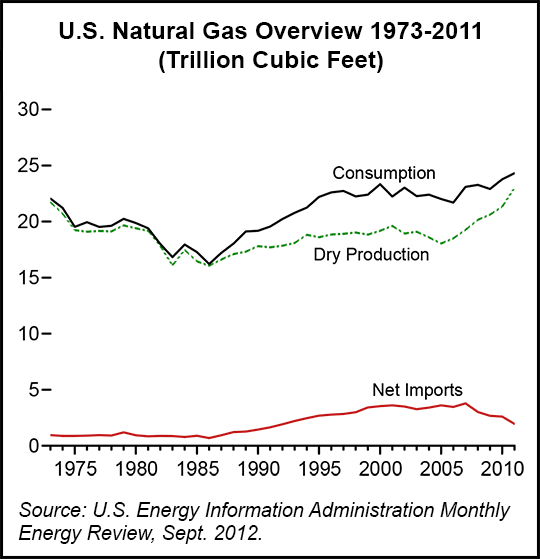NGI Archives | NGI All News Access
Shales Helped Push Natural Gas Production Up 1.74 Tcf in 2011
Inflated by production from the nation’s burgeoning shale plays, total gross withdrawals of domestic natural gas jumped to 28.58 Tcf in 2011, a 6.5% increase from 26.84 Tcf in 2010, and are on pace to easily surpass those numbers again this year, according to the U.S. Energy Information Administration’s Monthly Energy Review for September.

In the first six months of 2012, 14.90 Tcf has been withdrawn, EIA said, significantly more than during the first six months of 2011 (13.96 Tcf) or 2010 (13.13 Tcf).
Withdrawals, which decreased 678 Bcf in the 10 years between 1997 and 2006, increased 3.91 Tcf in the five years between 2007 and 2011, EIA said.
U.S. consumption of natural gas reached 24.31 Tcf in 2011 and was 12.97 Tcf through the first six months of 2012, on pace to surpass last year’s total, according to EIA data. Domestic dry gas production has increased steadily over the past few years, from 18.05 Tcf in 2005 to a high of 23 Tcf last year. And net imports of natural gas, which peaked at 3.79 Tcf in 2007, fell to 1.95 Tcf in 2011, and were just 791 Bcf through the first six months of this year, EIA said.
In a separate report issued Friday, EIA said Lower 48 production was 72.58 Bcf/d in July, an increase of 0.4% (0.29 Bcf/d) compared with June, and up 4.3% (3 Bcf/d) compared with July 2011. Total U.S. production for the month was 79.25 Bcf/d, down 1.8% compared with 80.72 Bcf/d in June but up a 4.4% (3.34 Bcf/d) compared with July 2011, EIA said.
Gross withdrawals from the federal offshore Gulf of Mexico (GOM) during July were 4.06 Bcf/d, up slightly from 3.99 Bcf/d in June, EIA said in its Monthly Natural Gas Production Report. The June number was revised downward from the 4 Bcf/d EIA had previously reported. Production in Louisiana (8.50 Bcf/d, compared with 8.49 Bcf/d in June) and Texas (22.13 Bcf/d, compared with 22.04 in June) was flat as well, according to EIA.
In late June Tropical Storm Debby caused the shut-in of up to 44.1% of daily oil production and 34.8% of daily gas production in the GOM, according to the U.S. Bureau of Safety and Environmental Enforcement.
“New Mexico had the largest percentage increase at 2.6% or 0.09 Bcf/d, which can be explained by new wells and completed maintenance,” EIA said.
For the month, Oklahoma produced 5.50 Bcf/d (compared with 4.48 Bcf/d in June), Wyoming 6.10 Bcf/d (compared with 6.17 Bcf/d in June) and the Other States category 22.68 Bcf/d (compared with 22.60 Bcf/d in June). Alaska’s July production was 6.67 Bcf/d, down a whopping 20.9% compared with 8.43 Bcf in June, but 10.6% (0.64 Bcf/d) higher than in July 2011, EIA said.
Recently EIA said the nation set several new records for natural gas in 2011, including gross withdrawals, the number of producing wells, domestic consumption, exports and dry, marketed and onshore production (see Shale Daily, Sept. 28). And domestic natural gas production will be at an all-time high this year and is expected to break that record for a third consecutive year in 2013, thanks in large part to the nation’s booming shale plays, according to EIA (see Shale Daily, Sept. 12).
© 2024 Natural Gas Intelligence. All rights reserved.
ISSN © 2577-9877 | ISSN © 2158-8023 |

